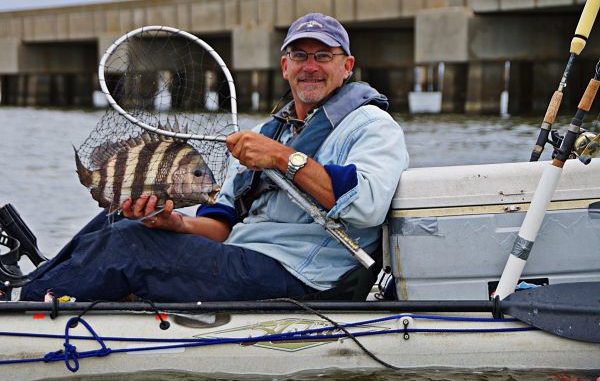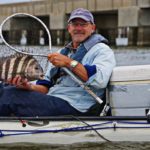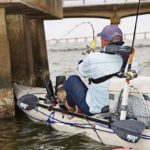
‘Trash fish’ offer plenty of winter action
Mark Sagerholm is an avid kayak fisherman and a self proclaimed “sheep herder.” Sagerholm has developed a great respect for sheepshead — what many Louisiana fishermen consider trash fish. Mark jokingly calls them “striped snapper” because of the tenacious fights once hooked, but he also knows they make excellent table fare.
I met up with Sagerholm recently for a trip to his favorite sheepshead grounds, the bridges of Lake Pontchartrain. Based on the day’s projected north winds, he decided to launch on the north shore where the waves would be knocked down a bit.
“I find that I catch larger sheepshead on the south shore, but it’s much more comfortable fishing the calm side,” Sagerholm said.
Though sheepshead are not picky eaters, Sagerholm’s go-to bait is live shrimp.
“It’s best to get smaller shrimp, if available, because sheepshead have small mouths and it’s easier to hook them if they can take in the bait with one bite.” Sagerholm said.
However, when live shrimp are out of season, he prefers market shrimp over live minnows.
“I’m a live-bait guy, but I find even dead shrimp will produce more sheepshead than live minnows,” he said.
Sheepshead love hard structure like pilings, piers and rock jetties. The bridge supports in Pontchartrain provide miles of barnacle- and algae-encrusted prime habitat. All of the bridges hold sheepshead, but the train bridge or “trestles” just west of the Highway 11 bridge is a regular producer. In addition to hundreds of pilings, it’s the lowest of all the bridges and provides more shade during the day.
Launching a kayak to fish the trestles or Highway 11 is easy. On the north shore, a sand ramp at the old Tite’s launch is at the base of the Highway 11 bridge. On the south shore, you can launch near the base of the Highway 11 Bridge, and it’s about a mile paddle to get to the trestles.
On our paddle out, Sagerholm put his fish finder on split screen to show both depth/fish and marked GPS locations.
“In addition to all of the bridge supports, there are several sunken pilings that I marked during an extremely low tide,” Sagerholm said.
He believes the more structure the better, and had plans to target these newly found attractions.
Sagerholm also put forth an unusual hypothesis.
“I always seem to catch a fish when a train is passing,” he said with half-kidding confidence.
More on that later.
He ties his own sheep-catching rigs, which are modified bottom dropper rigs. With 30-pound braid as his main line, a 3-foot length of 30-pound fluorocarbon leader is spliced into the main line with a uni knot. A length of 25-pound monofilament is tied to a swivel to make his dropper rig, which is terminated with a 1-ounce bank sinker. It’s tied so that the dropper and small No. 8 extra-strong treble hook sits only a couple of inches above the sinker.
The braid and fluoro provide abrasion resistance, and the lighter mono allows the hook to break off easier so the whole rig is not lost if snagged
The advantage of kayak fishing the bridge supports is that you can get right on top of where the sheepshead are holding. Sagerholm’s favorite technique is to face the kayak into the wind and tide. He pedals up and holds position with one hand against a piling while dropping his bait straight down so it rests where the piling is blocking the current.
“The sheepshead will hold in these spots just waiting for bait to wash around the piling,” he explained.
Sagerholm prefers using a baitcast reel, since all he has to do is press the button and let the bait fall to the bottom — no casting is necessary. He will try all sides of the pilings until he can establish the day’s pattern of where the fish are holding.
After trying several pilings with just a few half-eaten shrimp to show for it, Sagerholm suddenly lit into a fat 18-inch “striped snapper.” After setting the hook, he quickly muscled the fish away from the pilings. The current and wind will usually move the ’yak away from the bridge so the fish can be fought with less chance of getting cut off by the crusty, sharp pilings.
This time, everything worked as planned and in only a couple of minutes, the fish was in the net.
Pretty much anything dropped while kayak fishing will end up in the water. That includes fish. Once the fish is in the net, it never leaves until Sagerholm flips it out of the net and into the ice chest. It stays in the net for hook removal and even photos. Sheepshead have sharp teeth, needle-point spines and razor-sharp gill plates. By keeping them in the net they are much easier to handle without injury or escape.
One of the attractions of fishing sheepshead from a kayak is the fish’s powerful fighting ability. Once yanked free of the pilings, the fish fight vertically rather than making wide runs. Stout rods and heavy line allow you to quickly get them under control and minimize break-offs.
Bottom fishing around hard structure and lots of trash means that you will spend a lot of time during the trip tying on new rigs. The good news is that this can be done quickly, and the terminal tackle is inexpensive.
Sagerholm meticulously moved from piling to piling, trying a new one after a few minutes with no bites. By the end of the trip, he put eight fat sheepshead into his chest, and had broken off and lost several more.
Back to the train: Sagerholm located one of the sunken pilings on his GPS and was moving into position when he noticed a freight train was approaching from the south. I sarcastically remarked that fishing the added structure along with a train passing would be the “perfect storm.”
With the train loudly clanking overhead, Sagerholm made a drop and almost immediately stuck a 22-inch sheep.
Coincidence or savvy technique? Who knows, but if you fish the trestles, Sagerholm highly recommends you have bait in the water whenever a train is passing!


